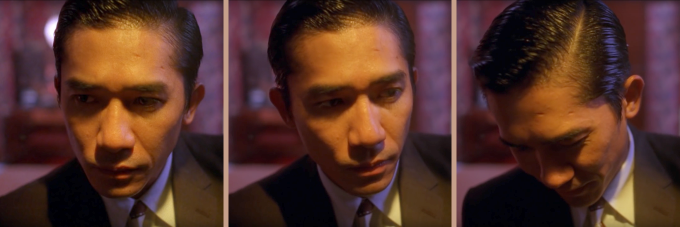Emotion Takes Time
Sun May 15 2016

In the Mood for Love (2000)
A few days ago I saw an excellent video on the YouTube channel Every Frame a Painting, all about how film editors choose when to cut from one shot to the next. It is well worth watching, and I suggest you take 10 minutes to do so.
While the video is all about film, I couldn’t help but feel it had something to say for writers as well. Now that I’ve had a chance to think it over some, I believe the lesson is this:
Emotion Takes Time
Look at the first frame at the top of this article. Imagine that was all you saw. Imagine that the film’s editor had only given you that one look. Do you get a sense for the character’s emotion? Kind of, but it’s thin. He looks kind of blank. Maybe a little stern? You get something, but it’s hard to tell quite what it is.
Add the second frame, and your sense of his emotion becomes much clearer. The look to the side, the tilt of his head, conveys an inner turmoil. Whatever he’s feeling, he is clearly uncertain about something.
Add the third frame, and bam. There’s the payoff. He’s facing downward, his eyes are slightly crinkled at the corners, and his mouth is drawn back in an expression we all recognize: anguish.
Now imagine all you got was the last frame. By itself, what does that convey? Puzzled, maybe? Vexed? Why is he looking down? Did he drop his keys? The emotion is far less clear without the buildup.
Buildup and Release
To convey an emotion, you can’t just show the beginning point. You can’t just show the endpoint either. Neither one is enough on its own.
The reason is clear: emotion is an arc, not a moment. It begins, builds, and eventually culminates. Emotion always comes in the context of what has gone before, and as a sequence.
Thus, as Every Frame a Painting tells us, the competent film editor doesn’t just give the moment of culmination. They give the whole sequence of the arc. Yes, the particular sequence illustrated here only takes a few seconds of screen time. But it’s a few seconds, not just a momentary flash.
How do Writers Apply this Lesson? Three ways:
Show the Sequence
Print behaves differently than film, for many obvious reasons. Just the same, if you’re going to convey an emotion with power and innate believability, you still need to show the setup, the buildup, and the culmination.
Too often, I’ll see writers try to convey an emotion by jumping straight to the last frame, as it were. They’ll show the abusive boyfriend’s rage by having him suddenly grab an empty beer bottle off the coffee table and hurl it across the room.
On some level, yes, readers will get that he’s angry. But it’s thin.
As readers, we’d much rather see that moment when something happens to trigger his rage. What was it? Did his girlfriend happen to ask him a question just as the wide receiver was about to catch the ball, so he missed seeing the touchdown? Whatever it was, show that moment. Show us the seed of the emotion.
Then, we want to see it building up. We need something to understand that he’s starting to boil inside. What does he do? Does he get off the couch and pace around a bit? Do his fists clench? Does he bark at her, "Hey, I’m watching the game, here!" Show us the build-up.
The trigger and the build-up foreshadows what’s about to happen. It’s the first two frames in the film.
Only after we’ve seen the foreshadowing do you give us the culmination of the girlfriend interrupting again with "Can I get you a beer?", which pushes him over the edge so he grabs that bottle and throws it. Maybe he also yells, "If I want another beer, I’ll goddamn tell you!"
Give us the whole sequence, and we’ll believe his emotion to our core.
Create a Sense of Time
Emotion takes time, so you have to find ways to create a sense of time within your narrative. You can’t just give us:
Sandy asked, "Hey, what do you want for dinner?"
Jack turned, just as the wide receiver caught a pass in the end zone. "Huh?" On the TV, the crowd roared. "Hey, I’m watching the game here!"
"Sorry," Sandy said. "Can I get you another beer?"
"If I want another beer I’ll goddamn tell you!" Jack grabbed an empty off the coffee table and hurled it across the room, missing Sandy’s head by inches.
It’s too fast. Bam-bam-bam, the events come too rapid-fire. While the elements of trigger and build-up are there, they pass by too fast for readers to appreciate them as foreshadowing. Presented this way, we feel like the whole four-paragraph sequence took maybe ten seconds of real time. To us, it doesn’t feel like Jack had any time to seethe before boiling over.
You can create a sense of time using body language, as I wrote about in last week’s article. You can also create a sense of time just by including other events in between the moments of the emotional arc:
Sandy asked, "Hey, what do you want for dinner?"
Jack turned, just as the wide receiver caught a pass in the end zone. "Huh?" On the TV, the crowd roared. "Hey, I’m watching the game here!"
"Sorry," Sandy said.
Jack crossed his arms, glowering as he watched the replay. "You made me miss the play."
"Sorry," she said again, but softer this time.
The announcers droned on about pass completion rates. Jack drained the last of his longneck and thumped the empty down on the coffee table.
"Can I get you another beer?"
"If I want another beer I’ll goddamn tell you!" Jack grabbed the bottle off the coffee table and hurled it across the room.
It’s not much extra. Just the three paragraphs in the middle. But they help readers sense the passage of time. Jack’s crossed-arm body language and his glowering conveys the build-up. Mentioning the replay indicates time, because most people have a sense for how much time a football broadcast will spend on a replay of a great touchdown pass. Jack’s extra dialogue also takes time, as does her repeated apology.
Notice, how her second apology gives an opportunity to convey Sandy’s emotions too. The earlier version was all about Jack, but if we think about the whole scene surely Sandy is experiencing some strong emotions as well. Let’s not leave her out.
The extra additional events of the announcers’ commentary plus Jack finishing a beer gives us yet more time, while also setting up the bottle-throwing that’s to come.
Linger on the Culmination
Finally, you can drive home the emotion by spending extra time on the emotional arc’s culmination. The video linked above talks about this in some detail, and again, I’ll encourage you to watch it. The example in the video does this through reaction shots of all the characters in the scene.
That technique can work just as well in narrative, but it’s not the only technique. Depending on the situation, you can also linger by fleshing out the events of the culmination. That is, don’t just say Jack threw the bottle across the room. Give us more:
"If I want another beer I’ll goddamn tell you!" Jack grabbed the bottle off the coffee table and hurled it across the room.
Sandy flinched, her arms flying up to cover her face. The bottle whished past, missing her head by inches, and exploded against the wall behind her. Glass sprayed everywhere. Shards pinged off the dining table, Sandy’s back, and flew into the adjoining kitchen.
"Now clean that shit up and leave me alone!"
Audiences Need Time
Emotion take time to convey because audiences need time to process it. When you were writing your scene, you had all the time you wanted to think, feel the characters’ emotions, and write it down. We don’t have that luxury, yet we still need to sit with the emotions for at least few moments in order to experience them along with the characters.
Film controls the pace at which audiences experience the story. Thus, films can quite literally give viewers more time: they just let the shot linger on an actor’s face for a few more seconds, they add another character’s reaction shot, et cetera.
In writing, you don’t control the pace at which the reader experiences the story. Some people read fast, some read slow. Thus, you need to employ the techniques described here to create the space for readers to fully experience the emotion of your scenes.
 @sonjablack.bsky.social
@sonjablack.bsky.social